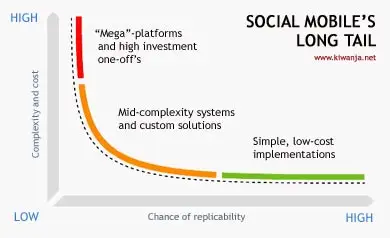Is mobile development repeating ICT4D errors?
In the mobile and development list of Dgroups, Prof. Richard Heeks wrote this message recently:
There's a notion that "m-Development" will be more attuned to the needs and context of users than was the initial round of ICT4D projects (what we might call "ICT4D 1.0"). But I wonder if, in fact, some of the some mistakes aren't being repeated. I've come across a couple of project descriptions in recent days - using mobiles in the health sector in South Africa; using them in the agricultural sector in West Africa - where the projects have been designed and driven by technical staff, and which turned out to be technically well beyond both the technological and human infrastructural readiness of their intended user settings. This techno-centric approach was a characteristic of the first ICT4D projects, and it would be disappointing if the m-development field equally started to get ahead of itself; forgetting that the main uses in poor communities are voice and, to some degree, SMS on basic handsets.
This triggered an interesting discussion among some of the people who were in the list. For example, Steve Song, who has an interesting new blog, wrote:
I think you will always get technocentrics chasing new ideas and applications of technology without a clue about development, just as you will get development people chasing new ideas without a clue about technology.
I think that the difference with m-development is that you stand a) a closer chance of developing something scalable, affordable in developing countries and b) you potentially open the doors to innovation simply by putting tools in play, witness beeping, SMSing, air-time transfers, m-Pesa. Jan Chipchase of Nokia Research points out that Nokia has no idea what the future of mobiles looks like. They are trying to design to enable innovation.
And Patricia Mechael added to the discussion:
Often times, people start with the technology and look for ways to apply it to address development objectives rather than looking at development objectives and then identifying tools (high and low tech) to help leverage their achievement. In relation to mobile phones one area that has not been well studied or documented is the role of basic two-way voice communication within a broad range of development activities.
Anthony Makumbi emphasized the importance of livelihood:
My view is the only way this can be avoided is to build technology on existing livelihood development programs. Technology comes in to enhance particular areas of the livelihood programs. Here you are introducing technology to the end user with a direct meaning unlike projects designed from the blue with different sentiments and imaginations, with no direct fit with the normal livelihoods of communities. With that said, with the mobile phone there is great potential in getting a direct community fit and with the current penetration rates of the Mobile phone in Africa, there is a mass opportunity in the adoption rate within rural communities.
In my opinion, ICT4D had many challenges in the past, but nowadays there are more opportunities to do differently. Two decisive developments are mobile phones and web2.0. One allows finally massive access, sharing information and communication technologies, and the other brings the potentials for collaboration and a multitude of creative applications to its users.
Ken Banks from kiwanja.net has an fascinating post about "Social mobile and the long tail", where he argues the great potential of low cost solutions with mobile phones, and made this excellent graphic. He writes, "Solutions are tantalisingly close, but without the tools and a practical helping hand, most of these NGOs remain passive observers." Two interesting events around this event will be held this year. One is a conference organized by W3 called "Workshop on the Role of Mobile Technologies in Fostering Social Development" and another is the MobileActive08: Unlocking the Potential of Mobiles for Social Impact.
